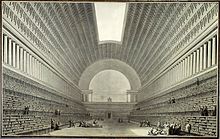Étienne-Louis Boullée
Étienne-Louis Boullée | |
|---|---|
| Born | 12 February 1728 Paris, France |
| Died | 4 February 1799 (aged 70) Paris, France |
| Occupation | Architect |
| Practice | Neoclassicism |
| Buildings | Hôtel Alexandre |

Bibliothèque du Roi (1785)
Étienne-Louis Boullée (12 February 1728 – 4 February 1799) was a visionary French
Life

Born in Paris, he studied under
Geometric style
It was as a teacher and theorist at the
For Boullée regularity, symmetry and variety were the golden rules of architecture.
Cenotaph for Sir Isaac Newton

Boullée promoted the idea of making architecture expressive of its purpose, a doctrine that his detractors termed
Salon for the Hôtel de Tourolles
The boiseries, still often dated in the mid-1760s, were discussed in the issue of L'Avant-coureur for 21 January 1761, and so must have been carried out about 1758–59.[4] The Hôtel in the Marais district remodelled for Claude-Charles-Dominique Tourolle survives (the rue d'Orléans is now the rue Charlot) but the salon's boiseries and chimneypieces were removed in the mid-nineteenth century to a house in the rue du Faubourg Saint-Honoré now in the possession of the Cercle Interallié. Round-arched mirrors over the chimneypieces and centering the long wall in a shallow recess are disposed in a system of stop-fluted Ionic pilasters. White marble draped caryatid therm figures support the chimneypiece's tablette. There is a full architrave under a dentilled cornice. The white-and-gold ensemble would still have been fully in style in 1790.
Hôtel Alexandre

The

Legacy
Boullée's ideas had a major influence on his contemporaries, not least because of his role in teaching other important architects such as Jean Chalgrin, Alexandre-Théodore Brongniart, and Jean-Nicolas-Louis Durand. Some of his work only saw the light of day in the 20th century; his book Architecture, essai sur l'art ("Essay on the Art of Architecture), arguing for an emotionally committed Neoclassicism, was only published in 1953. The volume contained his work from 1778 to 1788, which mostly comprised designs for public buildings on a wholly impractical grand scale.
Boullée's fondness for grandiose designs has caused him to be characterised as both a megalomaniac and a visionary. His focus on polarity (offsetting opposite design elements) and the use of light and shadow was highly innovative, and continues to influence architects to this day. He was "rediscovered" in the 20th century and has influenced recent architects such as Aldo Rossi.
Peter Greenaway's film The Belly of an Architect (1987) concerns a fictitious architect who is staging an exhibition devoted to Boullée's work. The film contains many visual references to Boullée.
Notes
- ^ a b c d e "AD Classics: Cenotaph for Newton / Etienne-Louis Boullée". 10 September 2014. Retrieved 4 October 2016.
- ^ Montclos Jean-Marie Pérouse de. Etienne-Louis Boullée, 1728–1799: Theoretician of Revolutionary Architecture. Thames and Hudson, 1974.
- ^ Proctor, Adam & Park, William (16 March 2016). "The memorial to Newton that would have eclipsed the pyramids". BBC. Retrieved 21 March 2016.
- ^ Eriksen 1974:298 and pl. 35
- maréchal Soult, from 1802 to 1818, whose name it now also sometimes bears.
Bibliography
- Jean-Michel Faidit, Spheres and starry temples in the Enlightenment : Boullée's Newton Cenotaph, architectural precursor to Planetaria ? Revue Planetarian, December 2003, pp. 6–13.
- Boullée & visionary architecture ed. ISBN 0-85670-157-2.
- Boullée's Treatise on Architecture by Étienne-Louis Boullée, ed. by Helen Rosenau, pub. Alec Tiranti, Ltd. London: 1953 First Edition
- Étienne-Louis Boullée(1728-1799: Theoretician of Revolutionary Architecture) by Jean Marie Perouse De Montclos, pub.George Braziller; ISBN 0-8076-0672-3; (February 1974)
- Visionary Architects: Boullée, Ledoux, Lequeu by ISBN 0-940512-35-1; (July 2002)
- Les architectes de la liberté by Annie Jacques & Jean-Pierre Mouilleseaux, collection "ISBN 2-07-053067-1; (November 1988) [In French]
- A Dictionary of Architecture, James Stevens Curl, Oxford University Press (1999).
- "Boullée, Etienne-Louis (1728 - 1799)", The Hutchinson Encyclopedia, Helicon (2001).
- "Boullée, Etienne-Louis (1728 - 1799)", Crystal Reference Encyclopedia (2001).
- Patricia Likos Ricci, "Lux ex Tenebris: Étienne-Louis Boullée's Cenotaph for Sir Isaac Newton," Proceedings of the Fourth International Conference on the Inspiration of Astronomical Phenomena, Magdalen College, Oxford University. (Bristol, UK: Canopus, 2005) 355–370.
- Robin Middleton, "Boullée and the Exotic," AA Files, 19 (1990), pp. 35–49.
- Svend Eriksen, Early Neo-Classicism in France 1974. (London: Faber) translated by Peter Thornton.
External links
- Boullée exhibit at Bibliothèque nationale de France
- Ministère de la Culture (in French)
- Internet architecture resource
- Successor to the Académie Royale d' Architecture
- Movie: The Belly of an Architect (1987)
- 3D model of Newton Cenotaph
- An overview of Boullee's designs in "The Impossible Architecture of Etienne-Louis Boullee" from the digital magazine, Aeon.
